From the Jungle – Two Days and a World Away
31 March 2003
Day 1
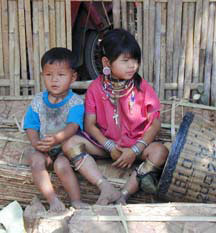 For tourists, the northwestern town of Mae Hong Son is a provincial capital and departure point for elephant, rafting, and
hiking treks through mountainous jungles. For us, it was departure point to remote hill tribe villages and to one refugee camp.
For tourists, the northwestern town of Mae Hong Son is a provincial capital and departure point for elephant, rafting, and
hiking treks through mountainous jungles. For us, it was departure point to remote hill tribe villages and to one refugee camp.
The majority population in the province is Shan, immigrants from the nearby Burmese state of the same name. Most are now Thai
citizens. There are also many Karrenni and Karen (pronounced quickly - ka-lee-ang), also immigrants from Burma. One group of Karen, the “long-necks” have become sight seeing attractions to the
Westerners whose tour dollars helped restore the once abandoned practice of girls and women wearing heavy brass rings around their necks, arms and legs. Another group of Karen girls and women 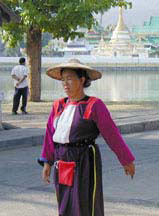 draw less attention by wearing the earrings that stretch large
holes in their earlobes. Mae Hong Son province is also home to interesting, ethnically dressed Lisu, Lahu, Hmong, Chinese, and other ethnic groups, some with and some without legal status, though more of
draw less attention by wearing the earrings that stretch large
holes in their earlobes. Mae Hong Son province is also home to interesting, ethnically dressed Lisu, Lahu, Hmong, Chinese, and other ethnic groups, some with and some without legal status, though more of 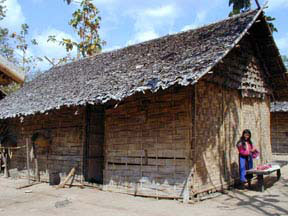 these groups are found in the far north near Fang and Mae Sai.
these groups are found in the far north near Fang and Mae Sai.
Two or more groups may live together in a village, but locals can tell from the style of their homes and from physical features and dress that they each have their own settlements within a village. For example, Shan and Karenni houses of bamboo are built on stilts. Lisu houses of similar material are built on the ground with slightly raised platforms inside for sitting and sleeping. The Chinese use lots of stone and adobe to build homes. Their roofs are sheet metal instead of broad leaf or palm thatch.
Our visit is during the hot season. Waterfalls are dry. Rice fields lie dormant and brown. Mango orchards, corn and soy bean fields dot the humid valleys. Freshly dug garlic hangs, drying in open sheds. Watermelon vendors line the roadways. Above the fields are forests where coarse, brown leaves rustle on the ground. Bare branches stretch high above. The scent of smoke lingers from scorched stubble and undergrowth. In the distance, white plumes mark new hotspots.
There are five of us in our tiny motorcycle powered tuk-tuk: the two of us, the uncle of one of our students who helps educate the refugees, (we will call him Saw, which actually means something like Mr. in English). Also with us is the eight year old blind boy Saw took in and, of course, the driver who likes to pick up speed on open stretches. We ride for an hour, pass several villages, then turn down a dirt road. Beyond a gate, we cross a low water dam that marks the beginning of the refugee camp. The tuk-tuk lurches and dips into giant holes. The driver swerves to miss a boulder. We hold tight hoping we won’t tip over. Men, women, and children working in the field stand up to watch us pass. Another ten minutes of grinding dust and we pull to a stop under a shady tree.
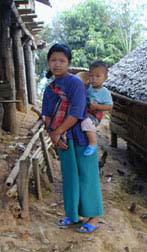 Camp 3 was once home to more refugees. Now only orphans and the injured or disabled are allowed to stay. More healthy
refugees have been relocated far from civilization, next to the dangerous Myanmar border at Camp 1 or 2. To reach either requires a two to four hour hike on foot.
Camp 3 was once home to more refugees. Now only orphans and the injured or disabled are allowed to stay. More healthy
refugees have been relocated far from civilization, next to the dangerous Myanmar border at Camp 1 or 2. To reach either requires a two to four hour hike on foot.
We take a sip of water and pry ourselves from the tuk-tuk. Our student’s uncle leads us up the steep dirt path to the orphanage. Dirt steps are cut out of the hillside in places. Huts line the trail where children carry babies on their backs. Mothers carry the larger ones with heavy bags of rice atop their heads. A man with an artificial leg carries another heavy rice bag up the sheer incline, then comes another, and another. The food shipment just arrived for distribution. We ask how so many people lost limbs. Saw tells us that most were injured by land mines.
We stop to catch our breath. Climbing is difficult in the heat. We can’t imagine how people make it up and down this trail in the rainy season. Surely everything turns to mud.
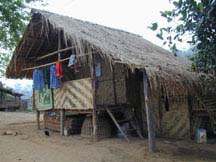 We pass a water storage bin where a girl washes herself. An old toothless woman smiles at us from her doorway. A 100 foot
square bamboo house is closed. It wears the
We pass a water storage bin where a girl washes herself. An old toothless woman smiles at us from her doorway. A 100 foot
square bamboo house is closed. It wears the 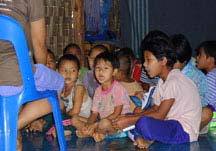 sign “Health Center.” At the top of the trail, we hear singing. A clearing opens to reveal six or more bamboo buildings. In one, woman leads singing for a group of
orphan children while another pays guitar. The long hall is their dormitory. They have no parents, just these caretakers. Their beds are pallets on platforms raised slightly off the floor.
Saw points out houses where older children stay, one for the young women, another for the young men. There is also a church. Many of these refugees are Christian and some are Buddhist. Women
sign “Health Center.” At the top of the trail, we hear singing. A clearing opens to reveal six or more bamboo buildings. In one, woman leads singing for a group of
orphan children while another pays guitar. The long hall is their dormitory. They have no parents, just these caretakers. Their beds are pallets on platforms raised slightly off the floor.
Saw points out houses where older children stay, one for the young women, another for the young men. There is also a church. Many of these refugees are Christian and some are Buddhist. Women 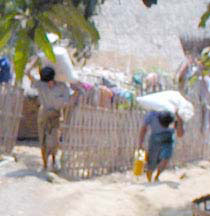 and children gather at the doorway where plastic chairs
form aisles. Today is Sunday.
and children gather at the doorway where plastic chairs
form aisles. Today is Sunday.
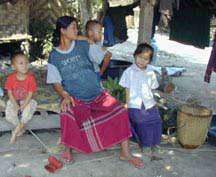 The people seem to get only rice, salt, sugar and cooking oil from outside sources. They must grow their own vegetables
. Saw shows us their experimental garden. He opens the door to a lean-to beside his house. Four rabbit cages sit empty, ready for the first breeding pairs to feed the orphans. They will
provide needed protein. Hiking back downhill and across the road, he shows us the fish pond he created with stalls for pigs above. We pass two boys catching fish with a net in the river. A woman washes laundry there.
The people seem to get only rice, salt, sugar and cooking oil from outside sources. They must grow their own vegetables
. Saw shows us their experimental garden. He opens the door to a lean-to beside his house. Four rabbit cages sit empty, ready for the first breeding pairs to feed the orphans. They will
provide needed protein. Hiking back downhill and across the road, he shows us the fish pond he created with stalls for pigs above. We pass two boys catching fish with a net in the river. A woman washes laundry there.
Back in Burma, Saw was a mining engineer. He earned $6 a month, not enough to live “People suffer a lot,” he says. He goes on to explain:
“Troops go into villages regularly to terrorize people. They are shot and killed. Women are violated. In Burma, only military children are allowed to be educated.
If our children are to learn, they must escape across the border. Our people aren’t stupid! They long to know all they can about the world. Some manage to find kind souls who help pay for them go to colleges and universities. Sometimes they encounter the military children there and are afraid, but they stay silent and only hope their families won’t be reported. The military rulers of Burma think they are strong because they make people fear them. They want the masses to stay uneducated . I think fear never works in the end. Real leaders care about their people. They earn the right to rule because they care. We only want what everyone wants: to be able to support ourselves, to raise families, and to live in peace. One day, I hope we can go home again, but until we do, we must help our children to become educated so they can become real leaders.”
There are 6000 children in three camps age 5 to 18. The numbers grow every year and this is not all the camps. Unlike in the U.S., the Thai government has no legal mandate to educate the children here. Some volunteers with outside NGOs and some educated people among the refugees have become the teachers. “We weren’t trained to teach,” Saw protests, “but we do the best we can.” Still there are few books, fewer materials, and little money. Refugees are not allowed to travel legally outside the camps so they are not allowed earn income outside the camps. Some sew decorative items for other’s to sell on the city streets. Some make baskets from the bamboo that grows nearby. Most survive on donations of food and blankets.
Saw is one who has a travel pass. He wrote a grant proposal requesting three heavy duty copy machines so they could print textbooks for schools in the camps. He got one and it is not heavy duty. This refugee camp is where the books are printed because it is the only one with electricity. From all the printing, the copy machine runs hot. Now it isn’t working very well. Something is wrong with the part that distributes the ink. The man who sold it to them guaranteed he’d make repairs but since, he has put them off. “If I just had a second copier”, says Saw, “we’d be able to let this one cool off sometimes.”
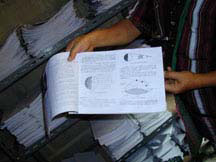 Saw shows us textbooks they’ve created…some in Burmese, most in English…math texts, biology books, physics, English literature, history, readers and on
and on. By the time the students reach the upper grades, all classes are taught in English. Students prepare for the TOEFL. Students like ours score above level 12 and dream of studying in Australia or Canada or
America. Some manage it. Most are not so lucky.
Saw shows us textbooks they’ve created…some in Burmese, most in English…math texts, biology books, physics, English literature, history, readers and on
and on. By the time the students reach the upper grades, all classes are taught in English. Students prepare for the TOEFL. Students like ours score above level 12 and dream of studying in Australia or Canada or
America. Some manage it. Most are not so lucky.
People at this camp are “lucky,” says Saw. Food supplies come by truck. Cross border raids by Burmese soldiers have difficulty coming this far into Thailand. We watch as two families dismantle their houses. “They already moved to camp 2,” he says, “because they are not disabled. They are here only to get these last few materials from their house here.”
There are more stories we hear, more people we meet whose names we dare not say, more lives that touch us, but it is time for us to return. Few Westerners are allowed into camps at all and none can stay overnight. We make our way back down the dusty rutted road, past the scent of garlic and smoke, on to the concrete roads that Thai’s enjoy. We return to our sparse guest house and sleep a restless night.
Day 2
The next day we wake early. The International Refugee 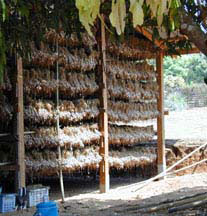 Committee field office director is to be in by 7:45. (We want to talk to her about our daughter and son-in-law
who will be coming to stay with us this fall. They want to do volunteer work in health care. She is finishing her third year clinicals in medical school back in the States.) A director from Bangkok and another from New York are
also here. Trainers and local people gather waiting for vans to take them to the health worker training site just outside town. Michelle is late. We sit and wait.
Committee field office director is to be in by 7:45. (We want to talk to her about our daughter and son-in-law
who will be coming to stay with us this fall. They want to do volunteer work in health care. She is finishing her third year clinicals in medical school back in the States.) A director from Bangkok and another from New York are
also here. Trainers and local people gather waiting for vans to take them to the health worker training site just outside town. Michelle is late. We sit and wait.
The chalk board has a note written on it: “Section 7 – 3 houses burned, 2 pigs killed” We think about our student whose parents and two brothers were shot only four short weeks ago – all dead. He was like a zombie for days. We think of the news article in yesterday’s paper about meningitis and malaria outbreaks in the camps. We think of what our students had written in their essays:
“The people are hungry. The children suffer from malnutrition. We have to call a doctor to come from the village if someone gets sick or hurt. Sometimes they are too late. We need a doctor in our camp.”
“People are afraid. There is no protection from soldiers who come and shoot at us. They burn our homes and destroy the rice.”
“It is not safe to build houses under trees. A tree fell on one house. We asked permission to build it again but this time away from the trees. They said no. It is very crowded in the camp.”
“The camp is noisy. There are so many people and new ones come every day. This is a problem when children try to have school. There is no room and it’s noisy.”
It is nearly 8:30. We decide that even if Michelle shows up, she will be in a hurry and have no time to talk. We speak with a medic from Bangkok. He says he will talk to Michelle.
At breakfast our little five year old friend (the owner’s daughter we presume) yells our order to her mother in the kitchen, then sits with us and jabbers away in Thai. She has a workbook for learning the Thai alphabet. She industriously prints the letter ต a Thai letter, over and over following the dots in the book.
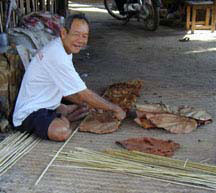 Our driver shows up to take us to villages near Mae Awe. It will be a day long trip there and back. We leave town behind. Pass more fields like the ones we
saw yesterday. We stop to see a man sewing newly fallen leaves for his roof. He shows us how he folds the leaf over the bamboo stick, then weaves a thinner stick in and out to hold it secure. He can make about 50 racks
in a day. It takes 700 for
Our driver shows up to take us to villages near Mae Awe. It will be a day long trip there and back. We leave town behind. Pass more fields like the ones we
saw yesterday. We stop to see a man sewing newly fallen leaves for his roof. He shows us how he folds the leaf over the bamboo stick, then weaves a thinner stick in and out to hold it secure. He can make about 50 racks
in a day. It takes 700 for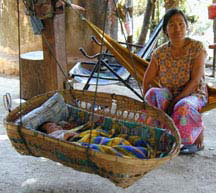 the roof. They must
be replaced in the hot season every year, before the rains begin. His wife keeps him company, rocking the sleeping grandson in a swing. Our driver says the people are Shan. They are called Thai Yai in Thailand, big
Thais.
the roof. They must
be replaced in the hot season every year, before the rains begin. His wife keeps him company, rocking the sleeping grandson in a swing. Our driver says the people are Shan. They are called Thai Yai in Thailand, big
Thais.
Farther down the road we stop again. This tiny village has no electricity. The nearby stream is dry, but the driver shows us the well for water at its bank. An old man uses his machete to slice strips from the board that forms the door to his house. It looks like a new house, fresh bamboo woven walls. We press against it, surprised how strong it feels. Racks of palm leaf thatch lay ready to replace the roof on a nearby house. A small boy walks past us with a scowl and stare.
Our next stop is a resort, an emerald green 12-hole golf course, a mud bath and hot springs, a sauna, a 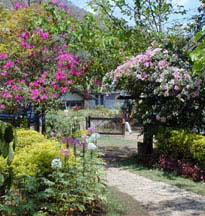 massage salon and a pool. Some workers trim hedges and bed new plantings. Others sit
under the shaded roofs talking in quiet voices, ready to serve. “You want massage? Or you want mud face mask?” one asks. “No” we shake our heads, “just looking today.” A
hundred shades of pink exotic flowers hang from trees. The scrapbook at the desk is full of photos, all sizes of Westerners caked in mud. It’s a stark contrast to the villages. We take a brochure and leave.
massage salon and a pool. Some workers trim hedges and bed new plantings. Others sit
under the shaded roofs talking in quiet voices, ready to serve. “You want massage? Or you want mud face mask?” one asks. “No” we shake our heads, “just looking today.” A
hundred shades of pink exotic flowers hang from trees. The scrapbook at the desk is full of photos, all sizes of Westerners caked in mud. It’s a stark contrast to the villages. We take a brochure and leave.
The narrow road climbs steeply. Broad leaf, banana and palm trees give way to pine forest. I could swear we caught a glimpse of 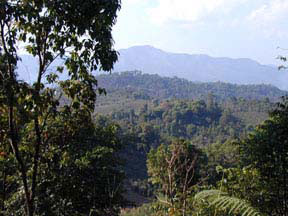 Aspen in the distance. The cool dry uplands are green. Escape
to them brings pleasant relief. People in straw hats transplant cabbage to new beds. Terraced fields stretch along the valley floors.
Aspen in the distance. The cool dry uplands are green. Escape
to them brings pleasant relief. People in straw hats transplant cabbage to new beds. Terraced fields stretch along the valley floors.
As we reach the top, green bushes sprout in rows like vineyards along the hillside. “Chaa” says the driver who speaks only Thai.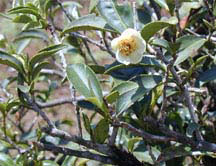 “Tea! How wonderful!”
we exclaim. We climb out, walk among the bushes, pick a few green branch tips to smell. We gather brown seeds that have fallen on the ground and wonder if they will grow back in Chiangmai.
“Tea! How wonderful!”
we exclaim. We climb out, walk among the bushes, pick a few green branch tips to smell. We gather brown seeds that have fallen on the ground and wonder if they will grow back in Chiangmai.
The air is refreshing and cool as we cross a gate into the village 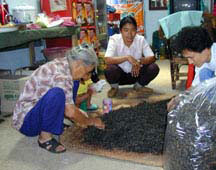 guarded by soldiers. One has his finger on the machine gun
trigger. The village lies around a small mountain lake. Chinese live on one side and Shan (or Thai Yai) on the other. The Chinese houses look different. Roofs are flatter. Walls are stucco and sometimes stone instead of
bamboo. Chinese characters painted red frame the doorways. Unlike Thai villages, this one has a town square, a gathering place. We stop for lunch at a shop where an
old woman and a child sit on the floor pulling large leaves from a pile of dried tea. Our “khao soy” is Chinese style, a tasty, spiced clear soup with noodles and pieces of grilled chicken.
guarded by soldiers. One has his finger on the machine gun
trigger. The village lies around a small mountain lake. Chinese live on one side and Shan (or Thai Yai) on the other. The Chinese houses look different. Roofs are flatter. Walls are stucco and sometimes stone instead of
bamboo. Chinese characters painted red frame the doorways. Unlike Thai villages, this one has a town square, a gathering place. We stop for lunch at a shop where an
old woman and a child sit on the floor pulling large leaves from a pile of dried tea. Our “khao soy” is Chinese style, a tasty, spiced clear soup with noodles and pieces of grilled chicken.
We walk across the square to a tea shop. The young woman makes a pot of green tea for us and then a second one of oolong. It’s free, she says, as we buy from her a dollars worth of leaves. Children play on the streets. One young boy is crying. A grandfather holds a baby in his lap. Unlike other hill tribe villages, homes appear substantial with open concrete courtyards. It’s a pleasant place and cool. We wish we could stay longer.
At the edge of town and up a gravel road we reach the end of Thailand. A soldier in the distance looks at us as we approach. We take a photo from the distance…any closer and it would not be allowed. Just past that pole painted red and white is Burma. Our driver turns around and we are on our way.
This time, in the woods just past the tea fields, we see a gathering of vehicles, Thai soldiers and guns. They seem to be meeting. We pass people resting at the town gate with baskets from their tea harvest. We pass a check point garrison where soldiers live in tiny huts beside the road. Again they refuse to let us take photos no matter how much we sweet talk with them.
By 4 p.m. we reach a Shan and Hmong village where people gather near a field for evening soccer games. The Queen’s Royal Project just past the village is home to 24 families, each with their own small plot of land, house, flower-covered gate, and sign that tells who lives there and how many people are in the family. It is a nice place, one long road clean and neat. One woman weaves green fabric on a loom under her house. A father gives his son a haircut. A grandmother holds her grandchild as the mother cooks.
One man has built three small guest houses. His daughter sews embroidery for the Royal Family. If she marries one day, he explains in toothless English, she and her husband will have to live on this same small plot of land or else move away to another town. He shows us the coffee trees he grows and serves us each a cup for a price that rivals Starbucks. Well, it is good coffee!
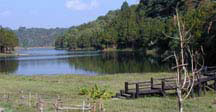 Beyond the housing row are helipads, up on a hill, the Queen’s residence and places for her guests. Beyond is a small, serene lake with green houses on one side and
hiking trails around. As lovely as it is here, there is something about this place that reminds us of a human zoo.
Beyond the housing row are helipads, up on a hill, the Queen’s residence and places for her guests. Beyond is a small, serene lake with green houses on one side and
hiking trails around. As lovely as it is here, there is something about this place that reminds us of a human zoo.
We weave our way back down the mountain. Cool air gives way again to heat and steam. It is nearly 6 pm. $25 had paid for 10 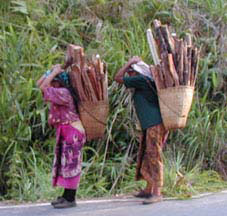 hours of the driver’s
time, the car and fuel. Our one last stop at a white Karen village is short. I take the opportunity to use their rugged outhouse. One man stops to talk to us in perfect English. We tell him we are teachers for
Karen and Karenni back in Chiangmai “You are welcome to walk around and take pictures” he says, but it’s time for us to go.
hours of the driver’s
time, the car and fuel. Our one last stop at a white Karen village is short. I take the opportunity to use their rugged outhouse. One man stops to talk to us in perfect English. We tell him we are teachers for
Karen and Karenni back in Chiangmai “You are welcome to walk around and take pictures” he says, but it’s time for us to go.
A second restless night and we are ready to head home to the comfort of our own bed. A section of the airport posts a sign: “This area for Buddhist monks only!” Air from the large Trane units outside cool us. We watch an HBO movie about a chimp in Canada. Our plane lands. We depart. Thirty minutes is all it takes, though the trip is 8 hours by bus.
Only two days in the jungle but somehow we think we will never be the same.